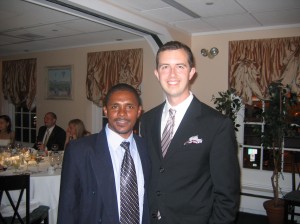We started the day off with a lecture from a global health economist from the Center for Global Development, Rachel Nugent, who is married to Congressman Brian Baird. She gave a lecture covering some basic economic theory and the relationship between economists and physicians, one that traditionally has been viewed with discord. I enjoyed her talk immensely and asked some questions about the concept of moral hazard applied to health care (see a piece on this by Malcolm Gladwell: http://www.newyorker.com/archive/2005/08/29/050829fa_fact). We had a good discussion between the audience and her about issues in calculating DALYs (disability-adjusted life years–a metric for determining cost effectiveness; see: http://www.who.int/healthinfo/boddaly/en/index.html) in projecting health cost-benefit analyses. As a politics and The Economist junkie, I find it interesting, although not at all surprising, how powerful a role economics plays in global politics – it’s certainly a religion in some ways or at least treated as a moral framework. Although inherently amoral (and not necessarily immoral), economic projections seem in the calculus of many decisions to somehow make cost-benefit analysis a moral value in situations where it arguably should not be, and one that conflicts with principals of ethical frameworks. For many health care workers, the discord can lie there within.
We discussed how modifying life-expectancy values in order to make the DALYs (and by extension, cost-benefit ratios) of certain interventions in low- and middle-income countries “more fair” can be tricky. I felt that we should use the metrics as they stand, rather than tweak them to seem more attractive for justifying an intervention, and then impose a moral/justice-based argument to justify certain interventions rather than modify the economic metrics to appear to alter the cost-benefit ratio so that it alone is persuasive. As a result, you preserve the role of a moral value/framework rather than try to make the economic ratio a moral value in and of itself or at least the guiding one. (And yet, I know limited resources always exist and that could be a prudential concern for any moral argument.) For example, say you “save” 15 DALYs because of an intervention for a person in Togo. Yet, the same intervention in the US generates 50 DALYs because the life expectancy in the US is higher. Rather than alter the value for life expectancy in Togo using some other variable in order to increase parity for interventions there compared to the US, why not use the disparity to justify the intervention investment on other grounds, not necessarily economic. I, of course, need to finesse the argument (and to fully explain what I’m saying here I need more than a blog post) after studying some econ next year, which I hope to do through some reading, but my basic point as I thought through the lecture is that I prefer economics in health care decision-making at least, to remain amoral, which it is increasingly not in health care. These are some hasty thoughts, but I wanted to unpack them a bit as I think about it more longterm.
The next lecture on “Tobacco Research in the World” included some staggering statistics. Did you know that 330 million men in China smoke? From a public health perspective, it is astounding how many DALYs are lost, how many lives are lost prematurely, how many families become impoverished further, and the increase of health care expenditures occur all do to tobacco around the world. Certain global markets, especially in Southeast Asia, China, and India are only being tapped now with women in low-income countries the untapped party for targeted advertising. This was one of the most compelling presentations of the two weeks for me, researched very well, and attached with an important health message and warning. If I come across the slides, I will post some more facts that will probably surprise and astound you.
During the rest of the day we had a talk on “Translational Research to Create Technology Innovation in Global Health Practice” and social entrepreneurship in that realm and finished with group time to work on our hypothetical Request for Application proposal for our presentation.




